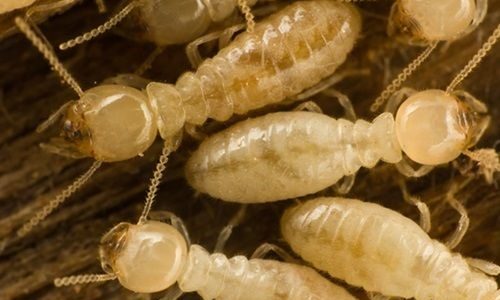What Is That Thing!? How to Recognize a Termite
- May 6, 2021
- in Pest Control
- by Ashley Dando

Termites are small pests that cause big problems—a $5 billion problem. Homes infested with termites face threats of serious damage. Termites eat the wood in a home from the inside out causing structural problems.
As these issues are not typically covered by insurance, preventing and spotting termite infestations is essential. Save yourself the cost and trouble of replacing the wood structures in your home when you learn to recognize a termite or signs of termites.
The first step to recognizing termites is understanding what kinds you might see in the wild or in your home. Not all termites are typically out in the open, so it is important to get to know each sort.
There are several types of termites in a given colony and it’s important to get familiar with the recognizable features of each.
Workers do much of the labor in a colony including getting food and keeping the young fed. These small, pale, blind termites stay inside the colony most of the time.
Soldiers protect the entries to the colony. They may be larger and have heavy jaws.
Swarmers are the winged termites more likely to be spotted outside of the colony. They have darker coloring and two sets of wings.
Finally, there are the queen and king who breed to produce the next generation in the colony. The queen tends to be noticeably larger than other termites due to carrying eggs.
Learn the following termite features to be able to spot these threatening insects as quickly as possible. In a situation where every moment counts, stop further damage to your home by recognizing termites. Call Safeguard Pest Control if you suspect any termites in your home.
Termites have white bodies or light brown bodies. Their bodies are darker at the head. They range from a few millimeters in length to 15 millimeters.
Termites can be identified by their distinct body shape. It is made of a front and back section. Wings, legs, and antennae are on the front section. The body is soft and a similar thickness throughout. The antennae are straight.
When spotting an unfamiliar insect that could be a termite, it is helpful to compare them to the more familiar ant. The ant’s body is three sections, with narrowness between sections. The body sections are hard. The antennae are angled.
Spot the deviations between the familiar ant and the insect you want to identify to determine if it could be a termite.
If you’ve got termites, you’ll be seeing wings both on creepy crawler pests and in piles around access points in your home.
Seeing a winged insect should recall the comparison of termites to ants. When comparing their wings, one sees that ant wings are longer on the front set than the back. Termite wings, however, are equal in length.
But even not on their bodies, you’ll see the wings. Termites shed their wings when “moving in.” These will accrue around the entrance to your home. It may be around your foundation or below windows and is a surefire identifier of termites compared to other winged insects.
Not all termites in a colony have wings. It is only termites that will reproduce that possess wings.
Winged reproductive termites are known as swarmers. Getting eyes on a swarm of winged insects is in another almost completely certain way to identify termites, and you can do so when you spot a swarm of flying termites.
Termites will congregate in the spring to mate or to expand their colony physically. You will only see these close to their nest, so spotting one in your yard could mean that you or a neighbor have some pests living in your walls.
Swarmers may be easier to notice due to their size. These tend to be slightly larger than the soldier or worker termites in the rest of the colony.
While there are a variety of insects that make some noise, termites make specific sounds during the consumption of your home’s wood that can help you identify their presence.
If you notice clicking or banging in your walls, ceilings, or floors, this can be a solid indication of termites. Termite chewing sounds like a steady clicking noise.
Banging comes from communication between the colony. It may mean a danger signal from the soldier termites.
Still unsure if that winged bug was a termite? Look for some of the distinct habitat signs termites leave behind to confirm.
Termites love to dig in the mud. Some live underground and leave very clear tunnel structures at their exit points that you may see against the side of your house.
Termites may extend these dirt structures into your home once an infestation takes root. In these cases, piles of dirt may appear indoors as well.
Conversely, you may also see nests in nearby trees. Termites devour the trees just like they do the wood inside your home. Look for chewed-up wood shavings, holes, or a damaged and dying tree. Termites may have hollowed it out.
Termites eat wood in many forms, not just your internal wall structures. Some of the first major signs you may notice indicating termites is damage to your wood fixtures or furniture.
If you think you’ve spotted a termite or two or three hundred, contact Safeguard Pest Control to get rid of these pests before you pay the price for their damage. We offer both termite inspections and termite treatment with sprays, barriers, and more to prevent serious damage to your home.
Get a free estimate with same-day service to tackle infestations quickly. Reach out to prevent damage and free your home from these pests.